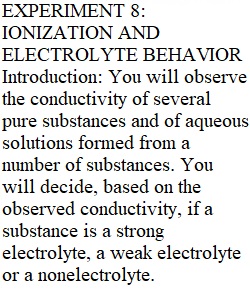


Q EXPERIMENT 8: IONIZATION AND ELECTROLYTE BEHAVIOR Introduction: You will observe the conductivity of several pure substances and of aqueous solutions formed from a number of substances. You will decide, based on the observed conductivity, if a substance is a strong electrolyte, a weak electrolyte or a nonelectrolyte. You will use observed changes in conductivity as a way to monitor the progress of a chemical reaction and to predict the products of the reaction. Background: Electricity can be viewed as a flow of charged particles, like electrons or ions. Very few pure substances, even ionic compounds, conduct electricity. The exceptions, the metallic elements and a few rare other elements and compounds, are important industrial materials. However, several types of substances conduct electricity when they are dissolved in water to make an aqueous solution. These substances are called electrolytes and include acids, bases and salts (ionic compounds). Salts and metal hydroxide bases already have ions present. Those ions separate, or dissociate, from one another as the solid salt dissolves. Ba(OH)2 (s) Ba(OH)2 (aq) Ba2+ (aq) + 2 OH¯ (aq) Molecular acids and bases consist of neutral molecules when pure. However, during dissolving, certain covalent bonds break to create ions. Thus electrolytes release free ions into the solvent. Those ions are free to move about in the solution and to carry current through the solution. Electrolytes are classed by how many ions they release into the solution. Some substances are 100% dissociated in solution; they are strong electrolytes. Soluble ionic compounds and a few acids like hydrochloric, nitric and sulfuric acids are strong electrolytes. HCl (aq) H+ (aq) + Cl¯ (aq) Other substances release only a few ions into solution with the bulk of the substance remaining associated; these are weak electrolytes. All slightly soluble salts and many molecular acids and bases (except the strong ones) are weak electrolytes. HC2H3O2 (aq) H+ (aq) + C2H3O2¯ (aq) These “weakly ionized” substances undergo a process of ionization and recombination until equilibrium is established, favoring the reaction to the left. This is the subject of later chapters in the text. Suffice it to say that only a few ions are produced. Your instructor may demonstrate conductivity, using an apparatus consisting of electrodes that are placed into the test sample and a light bulb that lights only if electrical current can pass through the substance being tested. The light bulb may shine brightly if there are many ions free to carry a lot of current or it may light only dimly if there are few ions available to conduct. In fact, it may not light up at all if there are almost no ions free to conduct electricity. Based on the behavior of the light bulb, you will classify the substance being tested as a strong electrolyte, a weak electrolyte or a nonelectrolyte. Alternatively – students may use individual conductivity meters that are connected to batteries. After observing a number of pure substances and solutions with a single compound mixed into water, you will observe a chemical reaction. Two dissolved compounds, H2SO4 and Ba(OH)2, will be mixed together while the conductivity apparatus continually tests the conductance of the mixture. By observing the light bulb, you will see evidence that a chemical change is occurring, and you can predict the identity of the products based on their electrolyte nature. Materials Procedure 1. Observe the brightness of the light bulb as your instructor inserts the test apparatus into each test sample. Decide if the bulb is bright, dim or not lit at all. Interpret these observations and decide if the test sample is a strong electrolyte, a weak electrolyte or a nonelectrolyte. Record your observations and conclusions in your notebook. 2. Observe and record the brightness of the light bulb when testing each of the two reactants, H2SO4 and Ba(OH)2, separately and during the mixing of the two compound solutions. Be alert to small gradual changes in the bulb’s light output. Write a brief explanation of these changes. Write the complete balanced equation for the reaction that takes place. Safety Svante Arrhenius, in the 1880’s , determined with great precision that ions contained charges which were specific for each element in solution, and varied between elements in exact multiples. So – Mg always had precisely the amount of positive charge as Na, etc. The Theory of Ionization contributed to the understanding of the true nature of electric charge. He also investigated kinetics and developed the formula for the energy of activation in reactions, and proposed that meteorites could have carried simple life forms to start life on Earth. EXPERIMENT 8: REPORT Ionization and Electrolyte Behavior Section Electrolyte Behavior Sample # Substance Conductivity (bright, dim or none) Electrolyte class (strong, weak or nonelectrolyte) 1 Deionized water 2 Tap water 3 Solid NaCl 4 1.0 M NaCl(aq) 5 Solid sugar, C6H12O6 6 1.0 M sugar, C6H12O6(aq) 7 HC2H3O2, glacial 8 1.0 M HC2H3O2(aq) 9 1.0 M HCl(aq) 10 1.0 M NaOH(aq) 11 1.0 M NH3(aq) 12 1.0M NH4Cl (aq) 13 1.0 M Ba(OH)2(aq) 14 1.0 M H2SO4(aq) 15 Saturated BaSO4(aq) observations from procedure 2: Ba(OH)2 + H2SO4 ? Questions: 1. Explain your observations as Ba(OH)2 solution was added gradually to the H2SO4 solution. Identify the products of the reaction and write a complete balanced equation. 2. Why is there a difference in the conductivity of pure solid NaCl and of the 1.0 M NaCl solution? 3. Pure (glacial) acetic acid doesn’t conduct electricity while 1.0 M aqueous acetic acid does, somewhat. Write an equation to show how acetic acid reacts with water to produce ions. (One of those ions is the hydrated H+ ion, written as H3O+.) 4. The 1.0 M acetic acid and 1.0 M hydrochloric acid solutions had the same concentration of molecules when the solutions were made. Do they have the same concentration of ions in the solutions that we tested? What is the evidence? 5. Did you see similar conductivity of the solutions of the two bases, sodium hydroxide and ammonia? Explain
View Related Questions